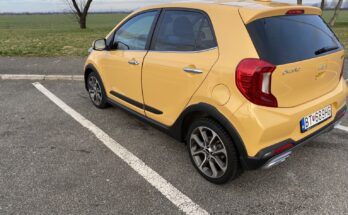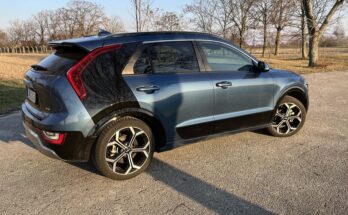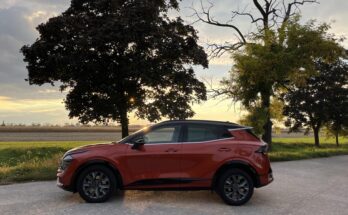As one of the first newsrooms in Slovakia, we were given the opportunity to test the third-generation Kia Ceed in domestic conditions. Ceed lost the apostrophe from the name, but gained in elegance, driving comfort and equipment.
From the outside
Today's lower middle class cars look like an egg, and sometimes it's not easy to match a model to a certain car brand. It is the same with the tested Kia. I will help myself with the importer's marketing slogan: " Ready to impress ", with which he presents the design of his new model. Let's compare it with reality.
Without looking at the logo and the radiator grille in the form of a tiger's nose, I would not have guessed the brand right away. Nevertheless, it is a well-designed car. I personally like it especially from the front, where the narrow and side-reaching headlights with the "Porsche" LED signature stand out. The sharply cut front bumper with tastefully placed fog lamps, which also fulfill the function of cornering lighting, is interesting. The aforementioned narrow grille visually widens the car and flows into the front wavy hood, which gives the car a muscular look. The windshield is finished with a cut-out in the form of a tiger's nose on the upper part.
Looking at the car from the side, I already find fewer design elements. Beautiful 17" alloy wheels (tyres 225/45R17) save large areas without significant overprints. Contrary to the current trend, this wheel size on the Ceed is, in my opinion, sufficient and does not disturb the side profile of the vehicle in any way.
The design of the rear part remained as conservative as the side. However, I praise the admitted exhaust tip, the distinctive spoiler and the nice LED "signature" of the rear lights. As one of the few brands, the rear LED lights are also used for daytime running lights.
The car gives an overall elegant and balanced impression, even if the side and rear parts lack something of the expression of the front part. Nevertheless, I was interested in its design, which is why I identify with the slogan of the importer to a large extent.
Inside
The front door surprises with its weight and when it closes, it almost makes a premium muffled sound. Their interior is made with an emphasis on design, but also practicality. It is made of high-quality plastics and artificial leather. I am pleased with the soft armrest and practically shaped handle, but I was struck by the use of piano lacquer.
When I got into the car, I was impressed by the nicely shaped steering wheel and the upper part of the dashboard. It is covered with a softened material into which you can sink your finger almost to the first joint. The infotainment display with a diagonal of 8" is tastefully integrated between the ventilation vents framed by imitation aluminum. On the other hand, the nested part of the center console with the controls for air conditioning, heating and seat ventilation looks a little dull, although on the other hand I like its slight turn towards the driver. Perhaps it would be enough to optically separate this part from the upper part, or use a different material…however, the perception of design is highly individual and some may like this solution. On the contrary, I welcome the conservative approach in controlling the basic functions of infotainment and air conditioning, which was reflected in the use of a number of single-purpose buttons. The value of the desired internal temperature is displayed directly on the rotary controls. However, they are less legible in sunny weather.
The central console between the seats is filled with a massive automaton lever embedded in an interesting surface with an imitation of aluminum and several buttons embedded in a plastic material covered with an impractical piano varnish.
To the left of the steering wheel is a set of other buttons used to control the intensity of the instrument panel backlight and to turn off some assistance systems and stabilization. I was surprised by the manual control of the height of the front LED dipped headlights, contrary to the automatic adjustment currently used. The TFT display between the tachometer and the speedometer shows the data of the on-board computer and enables extensive adjustment of comfort functions as well as assistance systems. I have no reservations about the devices as such, they are clear and easy to read.
The buttons on the steering wheel are made of high-quality non-slip material and serve to quickly control the basic functions of the audio system, switching the display of on-board computer information and adaptive cruise control. The lower part of the steering wheel is made of imitation aluminum, which, although it looks impressive, tends to collect unsightly "dactyloscopy marks" rather quickly.
The company's infotainment is clear, fast, with large icons and relatively intuitive. The display is sufficiently readable even in direct sunlight. However, controlling the car's functions in general exclusively by touch distracts from driving, in my opinion.
Apple Car and Android Auto are fully integrated into the system, so I used Waze exclusively instead of the built-in navigation. When using this solution, I am always disturbed not only by the mobile phone itself, but also by the connecting cable that connects it to the USB slot. This slot is located in almost every vehicle in the lower part of the center console in front of the control lever. It is no different in the tested vehicle. However, the Ceed offers a special space for wireless charging of a mobile phone located just below the buttons for controlling the heating and cooling of the seats. The phone can comfortably fit in that space, even with the entire connecting cable. However, the risk is that you will simply forget your mobile phone when you leave the vehicle.
Driving
As in every KIA model, I expected an above-average range of steering wheel adjustment in both directions. The new Ceed did not disappoint in this regard. Richly dimensioned and comfortable seats are still anchored a little high even in the lowest position. They are upholstered in black perforated leather, heated and, above all, ventilated, which is more the exception than the rule in this class. The cooling of the seats is very pleasant in the summer and eliminates sweating on the leather seats, on the other hand, if used unwisely, it can cause back problems.
I personally do not like the adjustable lumbar support because it is placed too high, a colleague from the editorial office had no problem with it. Otherwise, I was satisfied with the front seats, they have a long enough seat, a high back and decent lateral guidance. Their rear part is plastic, which will please parents with small children. The soft and four-way adjustable headrest was also comfortable.
Sitting behind the wheel is very pleasant, nothing bothered me or restricted me. The car is generously wide in the shoulder area, and there is also plenty of headroom. The mentioned wide range of adjustment of the steering wheel and seats makes it possible to comfortably sit down for any figure. I had no problem with the view from the vehicle, the only drawback is the relatively small rear-view mirrors. I have no reservations about the layout of the controls.
Ride
The tested model was powered by the company's four-cylinder engine with a volume of 1,353 cm 3 , an output of 103 kW at 6,000 rpm and a torque of 242 Nm between 1,500 and 3,200 rpm. The engine is quiet, refined and does not transmit any vibrations to the interior when idling. It is coupled with a 7-speed double-clutch transmission of our own production. So much basic technical information, details can be found on the importer's website. By the way, he presents the performance of the new Ceed as "Experience more, enjoy more."
In an effort to fulfill this slogan, I turn off the start-stop system, turn on Autohold and set off.
Even when driving very slowly, the gearbox shifts gently, without jerking or hesitation. I appreciate the speed of shifting from reverse to D mode. In NORMAL mode, the transmission software is tuned to achieve low consumption and keeps the revolutions at 1500. As the speed gradually increases, it imperceptibly shifts the next gear 500 revolutions higher. The logic of shifting individual gears is fine, but sometimes it happened to me that the transmission, let's call it medium acceleration, shifted gears quickly one after the other, which did not help the dynamics much. However, it was enough to gently press the gas pedal and the transmission allowed the engine to reach even higher speeds.
When trying to accelerate sharply, the transmission reacts in a flash and downshifts by 2-3 steps. So far, everything is ok, but… after gearing up, nothing happens for a while, then the engine starts roaring and only then does the car start accelerating. I expected a delay in the turbo, but I was surprised by the high time difference (up to two seconds) between pressing the gas pedal and the engine's response. The subsequent pull of the car is more than enough, so I believe that the manufacturer used too much turbocharger in the engine, which takes a long time to spin. However, switching to SPORT mode only partially eliminates this behavior, as the only difference between the modes is maintaining higher revs by engaging a lower gear.
Such a manifestation is typical for small-volume supercharged engines and must be taken into account. When overtaking, I got used to "preparing" the engine by partially pressing the accelerator, and the subsequent final acceleration took place without any problems.
It is felt that the manufacturer paid attention to tuning the chassis and achieved an excellent compromise between comfort and dynamics. The car overcomes normal road imperfections without disturbing sounds and does not transmit them into the interior. Larger transverse unevenness can be felt, but thanks to the multi-element rear axle, the chassis does not break even in corners. The car leans gently, but holds the track fiercely and reacts neutrally for a long time when adhesion is overcome. On a wet, slippery surface, I deliberately managed to get the car into a skid, when the whole thing pushed gently sideways out of the turn. When the gas was added, the car evened out naturally, even with the help of the electronics, and continued in a straight direction. The stabilization system intervenes gently, not too early and allows the car to be driven more aggressively. By holding down the corresponding button for a long time, it can be turned off completely, or such information appears on the display.
I also have an excellent feeling about the power steering setting. It is stiffer, but provides the same natural resistance in every position of the steering wheel. The car reacts quickly even to its subtlest movement and you can feel what is happening under the front wheels and it maintains a straight direction without the need for steering wheel corrections.
Aerodynamic noise remains at a very acceptable level even at highway speed, but the sound of rolling wheels can be heard mainly on rougher road surfaces. I was pleasantly surprised by the damping of the roof, when in heavy rain you could hear drops falling only from the windshield, which is rather an exception for Korean and Japanese vehicles.
I tested the car in city traffic, on county roads and on highways. I was pleased with the low consumption, despite the fact that it had driven only 4000 km. According to the on-board computer, the average consumption has stabilized at 6.5 l/100 km. I drove without striving for the lowest possible consumption with speeds slightly above the permitted limits. I assume that the car's appetite will decrease even more after driving another thousand km.
Consumption in the city depends on the traffic and ranges from 6 to 9 liters. The ride is pleasant, the car is nimble, has a small turning circle and a good view. Parking is facilitated by a rear camera with a decent resolution. Automatic parking works great, but I find it a little tedious to find a suitable free space and it's hard to imagine using it in normal city traffic full of nervous drivers. On the other hand, I enjoyed the driving assistant in the convoy and I could rely on him.
Okresky allowed the engine to show its ability to drive with low consumption. During normal driving, the on-board computer showed up to five liters of diesel. Aggressive driving in sports mode full of overtaking, braking and full acceleration did not drive this value over 9 liters. Driving in these conditions fully suits the car and the driver can enjoy it. The lateral guidance of the front seats will hold it in corners, and if it does not allow the engine speed to fall too low, the turbocharger will respond quickly and the car can go through corners at a relatively high speed under throttle.
Driving the car on the highway will also suit. At a speed of 135 km/h, the car passed the Bratislava-Žilina highway section with a consumption of 7 liters, the return trip under the same conditions even reduced it to 6.5. At a speed of 130 km/h, the tachometer in 7th gear shows approx. 2500 revolutions. As an interesting point, I will mention the possibility to turn off the adaptive function of the cruise control, which will allow maintaining its basic operation, e.g. during heavy snowfall. The manufacturer deserves praise for this, as not many car manufacturers offer such an option.
I enjoyed driving the Ceed mainly in connection with its comfort functions and equipment, the perfectly functioning adaptive cruise control combined with the lane keeping assistant, which managed to control the car even in sharp turns. Sporty driving was supported by an excellent chassis and a great automatic transmission, on the contrary, it was somewhat hindered by the tuning of the sports mode, which could not overcome the delay in the reactions of the small turbo engine. So if I have to compare the slogan "Experience more, enjoy more" with my real feelings, I can agree with it with small reservations.
Equipment and practical side
The manufacturer did not forget the practical side either. The car provides adequate interior space in the front and rear seats for a typical family of four with plenty of storage space. The high-opening 5th door reveals a view into the luggage compartment with a low loading edge and basically a layout with a volume of 395 liters. It offers a regular shape and a double bottom, hooks for shopping and a 12V socket. Although the rear seats cannot be folded down from the luggage compartment, it at least creates a flat surface with them. The spare wheel is not supplied in this equipment and is replaced by an adhesive kit.
The tested car had full equipment, which as of July 22, 2018 had not yet been published in the official price list. However, this is the First Edition equipment, supplemented by leather seats with heating and ventilation functions, a JBL audio system and a complete system of driving assistants, including adaptive cruise control. The price of around EUR 25,000 is high at first glance, but for a modern, fully equipped compact with an automatic transmission with a 7-year warranty (or 150,000 km), I think it is reasonable. I personally missed the levers under the steering wheel for manual gear shifting and the head up display, which is more and more popular even in the lower middle class.
Verdict
I think that the new Kia Ceed can certainly build on the sales success of its predecessor. A nice, if somewhat conservative European design, a powerful and economical engine combined with an excellent automatic, equipment until recently only supplied to luxury vehicles, a reasonable price, all this predisposes this model to mix up the lists of the best-selling cars in its class. Personally, despite the higher price, I would choose the Ceed in the tested equipment, which provided me with pleasant driving comfort. Perhaps I would still consider choosing a manual transmission, which, on the one hand, would not offer me the comfort of an automatic, on the other hand, if used correctly, it would help me eliminate the ailments of a small turbocharged engine and provide more dynamic driving experiences. The choice is up to each of us…



